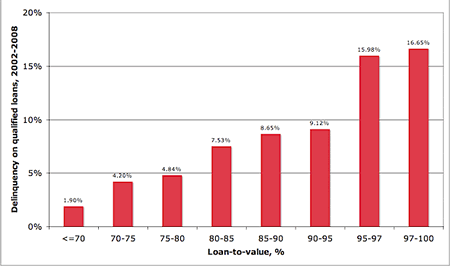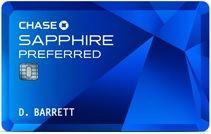As part of new reforms, the government is debating what downpayment size should be required for a “qualified” residential mortgage. If a mortgage doesn’t meet the new standards, the lending bank would have to retain 5% ownership even if selling the rest to investors. The initial proposal is for 20%, but of course the mortgage industry wants the required down payment to be as small as possible. They want to keep the good ole’ days from being able to offload the risk entirely onto others.
Honestly, if banks can’t handle keeping even 5% ownership of the loans they originate, why would I trust their underwriting at all? Their track record for determining creditworthiness hasn’t exactly been stellar. Of course, their public argument is that a low downpayment keep homes “affordable” for everyone. From the Washington Post:
“Why, in a law intended to fix the mistakes that caused the credit crisis, would you mandate a certain down payment when low down payments were not the problem?” said Kathleen Day, spokeswoman for the Center for Responsible Lending.
Actually, they are a problem. Felix Salmon points out how the mortgage industry is trying to influence people with misleading statistics, saying that “boosting down payments in 5 percent increments has only a negligible impact on default rates.” After some wrangling, Salmon got this clearer chart showing delinquency rates as a function of downpayment size for the period 2002-2008:

When the mortgage industry starts complaining about the 14 million people who would be denied the chance to buy a qualified mortgage if they don’t have a 5% downpayment, it’s worth remembering that qualified mortgages for people who don’t have a 5% downpayment have a delinquency rate of 16% over the course of the whole housing cycle. (You can be sure the numbers were much higher still in 2006 and 2007, which is why Guarino didn’t give them to me.)
And you can see too why the 20% downpayment limit was put in place: it’s the point at which delinquencies fall to less than 5%. If you take one group of loans with a 20-25% downpayment, and a second group of loans with a 15-20% downpayment, then the second group, on these numbers will have a delinquency rate 56% higher than the first.
The fact is, downpayment size does matter. Imagine what the chart above would look like with data from 2006 to 2009. It should serve as a reminder that giving anyone with a pulse a mortgage loan because it’s the American Dream was a bad idea.
A 20% downpayment was the standard when banks actually kept 100% of mortgage on their books. I’m not saying every single person should need 20% today; A bank should be able to create a mortgage that requires less, but in exchange it should have to have some skin in the game. If a lender won’t even keep a mere 5% on their books, doesn’t that just show the mortgage is too risky in the first place?
More reading: NY Times, ChicagoMag

 The Chase Sapphire Preferred Card is a rewards credit card offering new cardholders 50,000 bonus points after you spend $3,000 in purchases within the first 3 months. 50,000 points can be redeemed for $500 cash or two airplane tickets worth up to $312.50 each since they offer a 25% boost towards airfare and hotels. No annual fee for the first year, $95 in future years. They also offer 2 points per dollar spent on dining & 1 point per dollar spent on all other purchases.
The Chase Sapphire Preferred Card is a rewards credit card offering new cardholders 50,000 bonus points after you spend $3,000 in purchases within the first 3 months. 50,000 points can be redeemed for $500 cash or two airplane tickets worth up to $312.50 each since they offer a 25% boost towards airfare and hotels. No annual fee for the first year, $95 in future years. They also offer 2 points per dollar spent on dining & 1 point per dollar spent on all other purchases.  Amazon.com
Amazon.com If you do become a lender, be on the lookout for their “featured listings”, which currently offer a 4% upfront rebate on investments. Rebates are paid within 60 days of the date that your bid is placed. On $5,000 of investments, that would be $200. The fine print specifically states that you can double dip in this way:
If you do become a lender, be on the lookout for their “featured listings”, which currently offer a 4% upfront rebate on investments. Rebates are paid within 60 days of the date that your bid is placed. On $5,000 of investments, that would be $200. The fine print specifically states that you can double dip in this way: Per many reports from
Per many reports from  This is a follow-up on the previously mentioned 50,000 bonus points offer (converts to $625 in travel) for the getting the Chase Sapphire Preferred® Card. Thanks to readers Paolo and AT, they shared a way to get double those points, even if you’ve already applied.
This is a follow-up on the previously mentioned 50,000 bonus points offer (converts to $625 in travel) for the getting the Chase Sapphire Preferred® Card. Thanks to readers Paolo and AT, they shared a way to get double those points, even if you’ve already applied. The Best Credit Card Bonus Offers – March 2024
The Best Credit Card Bonus Offers – March 2024 Big List of Free Stocks from Brokerage Apps
Big List of Free Stocks from Brokerage Apps Best Interest Rates on Cash - March 2024
Best Interest Rates on Cash - March 2024 Free Credit Scores x 3 + Free Credit Monitoring
Free Credit Scores x 3 + Free Credit Monitoring Best No Fee 0% APR Balance Transfer Offers
Best No Fee 0% APR Balance Transfer Offers Little-Known Cellular Data Plans That Can Save Big Money
Little-Known Cellular Data Plans That Can Save Big Money How To Haggle Your Cable or Direct TV Bill
How To Haggle Your Cable or Direct TV Bill Big List of Free Consumer Data Reports (Credit, Rent, Work)
Big List of Free Consumer Data Reports (Credit, Rent, Work)